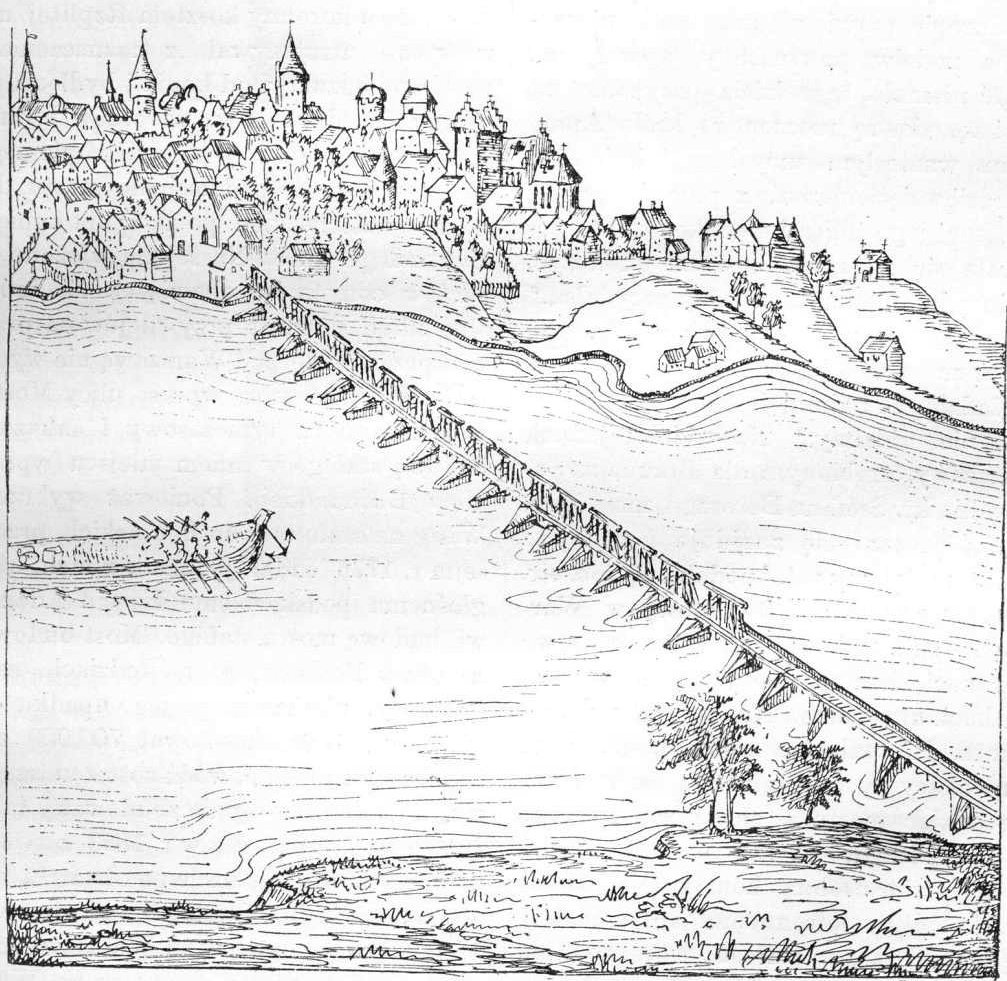Gdzie powstał najdłuższy most Europy XVI wieku? Oczywiście w Warszawie 😊
Budowę pierwszego stałego mostu w mieście rozpoczęto w 1568 roku z inicjatywy króla Zygmunta II Augusta. Decyzję o budowie przeprawy podjęto ze względu na szybki rozwój Warszawy, częste pobyty króla (miasto nie było wówczas jeszcze stolicą Polski) oraz fakt, że miała ona stać się miejscem wspólnych sejmów Korony Królestwa Polskiego i Wielkiego Księstwa Litewskiego po zawarciu Unii Lubelskiej.
Pierwszy pal wbito w dno rzeki 25 czerwca 1568 roku. Obiekt wznoszono według projektu Erazma z Zakroczymia. Po śmierci króla w 1572 roku budową mostu zajęła się Anna Jagiellonka, przeznaczając na ten cel również własne środki. Budowę mostu zakończono w 1573 roku, a w związku z tym wydarzeniem prowadzącej do niego ulicy nadano nazwę Mostowa.
Łączna długość mostu wynosiła ok. 500 m. Jako budulec posłużyły bale z drewna dębowego i sosnowego. Dębowe były m.in. podpory wbijane w dno Wisły. Most miał 22 przęsła o rozpiętości od 22 do 24 m, w tym 18 głównych, przerzuconych nad rzeką miało konstrukcję kratową. Przeprawa miała 6 m szerokości
W celu zabezpieczenia mostu przed pożarem, od strony ulicy Mostowej wzniesiono w 1582 roku murowaną basztę – Bramę Mostową. Pobierano opłaty za przeprawę, a porządku strzegła specjalna milicja. Zabezpieczenie przed krą stanowiły okute blachą izbice skierowane w górę rzeki.
Realizacja mostu była ogromnym przedsięwzięciem inżynieryjnym. Wisła rozlewała się szeroko, kapryśnie, a budowniczowie porwali się na budowę najdłuższej drewnianej przeprawy ówczesnej Europy. Wcześniej nie tylko Warszawa, ale i cała Rzeczypospolita nie widziała niczego podobnego.
Most musiał wywierać ogromne wrażenie na współczesnych. Dla szlachty przyjeżdżającej do Warszawy gdzieś z głębokiej prowincji był ósmym cudem świata. Pachniał drewnem i skrzypiał pod kołami powozów. Deski drżały pod uderzeniami końskich kopyt, a dołem przepływały dziesiątki łodzi i wielkie, flisackie tratwy.
Wisła była jednak groźna, a most delikatny. Każdej zimy trwała walka o jego utrzymanie. Kry uszkadzały przęsła oraz podpory i wiosną budowlę nakładem dużych kosztów trzeba było naprawiać. Działo się tak aż do 1603 r., kiedy to most uszkodziła powódź. Przestano go konserwować i z biegiem czasu rozpadł się zupełnie.
Where was the longest bridge in Europe in the 16th century? Of course in Warsaw 😊
The construction of the first permanent bridge in the city began in 1568 on the initiative of King Sigismund II August. The decision to build the crossing was made due to the rapid development of Warsaw, the frequent stay of the king (the city was not yet the capital of Poland) and the fact that it was to become the seat of the common Parliament of the Kingdom of Poland and the Grand Duchy of Lithuania after the conclusion of the Lublin Union (establishment of Polish-Lithuanian Commonwealth).
The first stake was hammered in the river bed on June 25, 1568. The object was erected according to the project of Erasmus of Zakroczym. After the death of the king in 1572, the bridge was built by Anna Jagiellonka, who also dedicated her own funds. The construction of the bridge was completed in 1573, and as a result of this event the street leading to it was named Mostowa.
The total length of the bridge was about 500 m. As a building material, the logs were made of oak and pine wood. Oak wood were among others supports imbedded in the Vistula River bottom. The bridge had 22 bays spanning from 22 to 24 m, including 18 major flanked by a river with a lattice construction. The crossing was 6 m wide
In order to protect the bridge from fire, from the side of Mostowa Street a brick tower was erected in 1582 – Mostowa Gate (existing until today). Transit fees were charged, and the militia guarded it. The protection from the ice flows were assured by a sheet of steep slabs directed up the river.
Bridge implementation was a huge engineering venture. Though Vistula spilled wide, was capricious, the builders aspired to build the longest wooden crossing in Europe. Earlier, not only Warsaw but the whole country did not see anything like it.
The bridge had a great impact on the people of the day. For the nobles coming to Warsaw somewhere from the deepest province it was the eighth miracle of the world. It smelled wood and creaked under the wheels of the carriages.
Vistula was dangerous and the bridge was delicate. Every winter there was a struggle for its maintenance. Ice flows damaged the spans and supports, and in the spring repairing was very costly . It lasted like this until 1603 when the bridge was damaged by the flood. It was stopped being repaired and then decayed completely.

